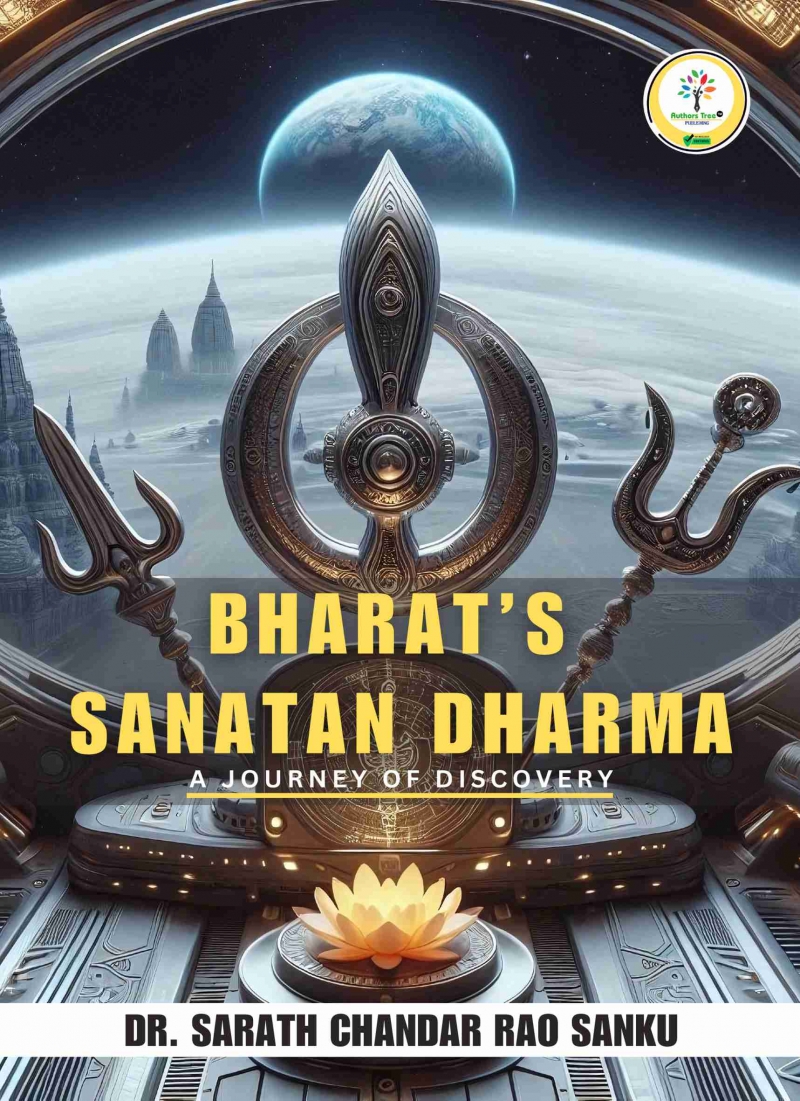
₹ 799
- Delivery Only India
- Status: In Stock
Bharats Sanatan Dharma
-
 Written byDr. Sarath Chandar Rao Sanku
Written byDr. Sarath Chandar Rao Sanku - Book TitleBharats Sanatan Dharma
ISBN - 978-81-977849-4-1
Publisher - Authors Tree Publishing
Pages - 404, Language - English
Price - Rs. 999/- Rs. 799/- only
(Flat Rs.200/- Off)
(Shipping Extra)
(Order Now: Paperback )
Category - Self-Help/Non-Fiction/Religious
Delivery Time - 6 to 9 working days
----------------------------------------------------------------------------------
Sanatan Dharma is a fusion of diverse traditions without any reference to a specific founder, creator, or writer. Initially established as a way of life, it gradually transformed into a religious system. Sacred texts like the Vedas, Upanishads, and Puranas were developed to guide practitioners. The four Vedas - Rig Veda, Sama Veda, Yajur Veda, and Atharva Veda - contain hymns, rituals, and teachings for daily life.
The concept of God in Sanatan dharma revolves around three natural elements such as fire, wind, and water. The ‘Trimurti’ or three idols being Brahma, Vishnu, and Shiva symbolizes the stages of life: birth, life, and death. Sanatan dharma (often called Hinduism) is not a religion but a philosophical way of life and with spiritual meaning. The Trishul or Trident has three prongs and it is very symbolic of the dharmic way.
The clear distinction among the three domains of cellular life, namely Bacteria, Archaea, and Eukarya, is evident in our existence. Despite their distinctiveness, it is noteworthy that eukaryotes are essentially a combination of archaea and bacteria, resulting from an endosymbiotic event that led to the emergence of mitochondria. This evolutionary process has greatly influenced the development of eukaryotes.
The three branches of Bharat’s government are the Executive, the Legislative and the Judiciary branches which is similar to the US Government.
The United Nations outlines three key principles of research ethics: Respect for Persons and Their Communities; Beneficence in safeguarding the physical, mental, and social welfare of individuals; and Justice in ensuring equitable distribution of risks and benefits among all communities, without favoring any particular group.
Transparency, Iteration, and Empowerment serve as the foundational principles of agile tools commonly employed within organizations.
This obviously prompts the inquiry: What are the advantages of embracing Agile practices? When can the outcomes be expected to materialize? How should one go about implementing Agile effectively? The answers are available via a simple Google Search and hence I shall not delve deeper into the details. Kindly bear with me.
Any Agile implementation involves the following three main steps as a start:
Stories, also called ‘user stories,’ are short requirements or requests written from the perspective of an end user or customer requirements.
Epics are large bodies of work that can be broken down into a number of smaller tasks (often referred to as ‘stories.’)
Initiatives are collections of several Epics that drive toward a common goal or mission of any organization.
{Disclaimer, I am a Certified Scrum Professional®-ScrumMaster and an Agile Coaching Skills - Certified Facilitator! QR links in the appendix for verification of my credentials.}
The pages of this book contain the account of my formative years spent at home, the education that molded me, the valuable lessons I learned beyond the walls of a school, the personal struggles I endured, and the triumphs I experienced throughout my life’s journey. This narrative serves as a prequel and companion to my previous work on the ‘Temple Ecosystem’ while also encompassing the essence of the Trishulam concept, in which I strive to uncover the guiding force behind our universe, our perceptions, our way of life, and our ultimate destiny.
About Author

Dr. Sarath Chandar Rao Sanku
Sarath is a Mechanical Engineer who spent the latter part of his life teaching English for high schoolers. He earned his Ph.D. in Machine Dynamics from the Indian Institute of Technology, Madras and he has worked in the Mechatronics industry, Information Technology, Consulting firms, and is a practicing Agile Project Management specialist serving industry in Japan for the past three decades. Over this same time, he has traveled to many ancient and cultural parts of the world.His first attempt at writing, ‘Temple Ecosystem: Paving the way for a sustainable Bharat and the World’ is a narrative about the most ancient and practiced dharma often referred to as Sanatan Dharma (Hinduism) and the future of Bharat with the imminent resurgence of the Temple Ecosystem. Sarath’s hobbies include book collections, reading, art, carpentry, travel, driving, and listening to music.The author moved from India to Japan in 1989 and he lives in Tokyo with his wife and two sons, all four still remain Indian Citizens.

